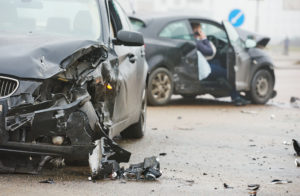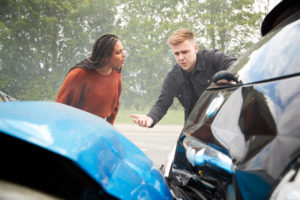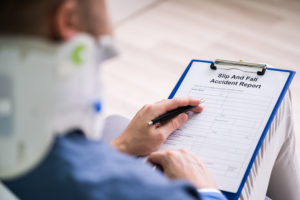Where Do Broadside Collisions Most Commonly Occur in Virginia?
Broadside collisions are some of the most dangerous types of car accidents. The point of impact being at a perpendicular angle, combined with speed, creates a highly dangerous outcome. In Virginia, our Richmond car accident lawyers at the Pendleton Law Team have experience representing these types of collisions and know firsthand the serious injury or even death it can cause.
To avoid becoming a victim, knowing where these broadside collisions happen most frequently in Virginia is critical. This article will expand on the elements of these types of collisions, including what causes them, where they occur most, and what you can do as a Virginia motorist to avoid the aftermath.
What Are Broadside Collisions?
A broadside collision, also called a T-bone collision, is when the side of one vehicle is impacted by the front or rear of another vehicle at an intersection or driveway. It is one of the most dangerous types of crashes, according to the National Highway Transportation Safety Association (NHTSA).
For a Free Legal Consultation
Call The Personal Injury Lawyer Hotline.
804-250-5050
Where do Broadside Collisions Commonly Occur in Virginia?
According to the Virginia Department of Motor Vehicles, the most common broadside accident locations are busy intersections in urban areas like Richmond, Norfolk, Virginia Beach, and Fairfax, especially on major routes. Rural intersections on state highways see fewer but deadlier broadside crashes at high speeds.
Here are the most dangerous intersections throughout Virginia where broadside collisions are more likely to occur:
- Bonney Rd. and S. Rosemont Rd.
- Brambleton Ave. and Park Ave.
- Centrewood Drive and Saint Germain Rd.
- Chesapeake Blvd. and E. Little Creek Rd.
- Courthouse Rd. and Hull Street Rd.
- E. Little Creek Rd. and Chesapeake Blvd.
- First Colonial Rd. and Virginia Beach Blvd.
- Gallows Rd. from Arlington Boulevard (U.S. Rt. 50) to Interstate 66
- Indiana River Rd. and Kempsville Rd.
- Kempsville Rd. and Indiana River Rd.
- Lafayette Blvd. and Tidewater Dr.
- Lee Jackson Memorial Highway (U.S. Route 50) and Metrotech Dr.
- Leesburg Pike (Va. Route 7) from Patrick Henry Drive to Rio Dr.
- Little River Turnpike (Va. Route 236) from Hummer Rd. to Woodland Rd.
- Lynnhaven Pkwy. and S. Lynnhaven Rd.
- Midlothian Turnpike and Turner Rd.
- Norview Ave. and Sewells Point Rd.
- Northampton Blvd. and Wesleyan Dr.
- Oaklawn Blvd. and Crossings Blvd.
- S. Independence Rd. and I-264 entrance
- S. Lynnhaven Rd. and Lynnhaven Pkwy.
- S. Rosemont Rd. and Bonney Rd.
- Staples Mill Rd. and Dickens Rd.
- Tidewater Dr. and Lafayette Blvd.
- Virginia Beach Blvd. and First Colonial Rd.
- W. Hundred Rd. and Meadowville Rd.
- Weslyan Dr. and Northampton Blvd.
Let the Heavy Hitters® Take On Your Case 804-250-5050
What Causes Broadside Crashes?
According to the Virginia Department of Transportation, the most common factors that contribute to the causes of broadside crashes include:
- Failure to yield
- Impaired driving
- Reckless driving
- Speeding
- Distracted driving
- Blind spots
- Lack of signage
- Weather conditions
- Defective vehicles
Central Virginia's Top Rated Personal
Injury Lawyers 804-250-5050
What Injuries Are Common in Broadside Crashes?
The injuries sustained by those involved in a Virginia broadside collision can occur anywhere and vary in severity depending on factors such as the speed of the vehicles, the point of impact, the use of safety equipment, and the overall design of the vehicles. The National Safety Council (NSC) reports that common injuries in broadside crashes include:
Head and Brain Injuries
The sudden impact of a broadside crash can result in head injuries ranging from mild concussions to more severe traumatic brain injuries (TBIs).
Neck and Spinal Injuries
Whiplash is a common injury resulting from the rapid back-and-forth movement of the neck during a collision. More severe injuries can include herniated discs or spinal cord injuries.
Chest and Abdominal Injuries
Injuries to the chest and abdomen can include broken ribs, lung injuries, and damage to internal organs.
Pelvic and Hip Injuries
Fractures, dislocations, and injuries to the pelvic and hip bones are common in broadside collisions.
Limb Injuries
Arms and legs can be injured, resulting in fractures, dislocations, and soft tissue injuries.
Facial Injuries
Injuries to the face may include lacerations, fractures, and dental injuries caused by striking the dashboard, steering wheel, or other parts of the vehicle.
Internal Injuries
Forceful impacts in broadside crashes can cause internal injuries, such as internal bleeding, organ damage, and injuries to blood vessels.
Post-Traumatic Stress Disorder (PTSD)
The emotional trauma of a broadside crash can lead to psychological conditions like anxiety, depression, and PTSD.
Whiplash
While more common in rear-end collisions, whiplash can still occur in broadside crashes due to the sudden jolt to the neck.
Burns
If a vehicle catches fire or there’s an explosion following the collision, burns can result from the fire or contact with hot surfaces.
Amputations
In severe broadside crashes, traumatic amputations of limbs can occur, especially if the vehicle is heavily damaged.
If you are involved in a broadside crash, seek immediate medical attention, even if injuries seem minor, as some may not be immediately apparent and could worsen over time.
Let Us Be The Heavy Hitters® For Your Case Speak To An Attorney Now
Who Is Usually At Fault in Virginia Broadside Wrecks?
Where the Virginia broadside collision happened will usually give insight into who is at fault. The driver failing to yield the right of way or running a traffic signal is typically at fault. However, determining fault in a broadside collision depends on the specific circumstances of the incident.
Liability is not solely based on the type of collision but rather on the actions and negligence of the involved drivers.
What Compensation Is Available After a Broadside Crash?
Injured victims may recover damages for medical bills, lost income, disability, pain and suffering, property damage, and wrongful death losses. In some rare instances, a judge may award punitive damages if the circumstances were egregious enough to warrant such action.
There are also non-economic damages, such as mental anguish and loss of consortium, that are recoverable but may require expert assistance to calculate.
How Long do I Have to File a Broadside Collision Claim in Virginia?
Virginia personal injury law has a statute of limitations of two years to file a broadside accident lawsuit. In some instances, depending on where the broadside wreck occurred, you may have a shorter time frame than that. Speaking to an experienced car accident lawyer in Virginia will ensure that you are informed of how long you have left to file for maximum compensation.
What to Do After a Broadside Collision in Virginia
Your priority following any collision should be to either file a police report if you are in stable condition or to get medical attention immediately. After seeking treatment, compile all of your documentation, such as accident scene photos, the crash report, and medical bills, and speak to a personal injury attorney who can evaluate your case.
If you are unable to speak to an attorney right away, do not give the other party’s insurance company permission to record a statement and avoid admitting fault of any sort.
Need Legal Help With Your Broadside Accident Case in Virginia?
No matter how common broadside accidents are or where they occur in Virginia, the Pendleton Law Team is well-versed in personal injury law involving car collisions and will fight hard to win your case. Our lawyers can investigate liability, negotiate optimal settlements, file a lawsuit if needed, handle court processes, and ultimately help you recover compensatory damages.
Contact us today if you have sustained losses from a broadside or t-bone collision in Virginia. Our consultation is free, and if you retain our legal services, you won’t have to cover any upfront costs until after your case is won.
The Pendleton Law Team Is Here For You 804-250-5050



